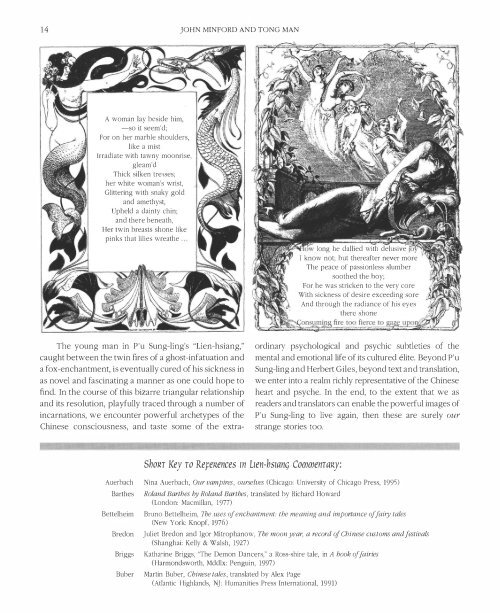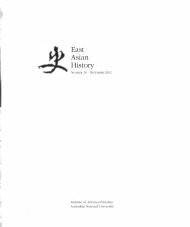Whose Strange Stories? P'u Sung-ling (1640 - East Asian History
Whose Strange Stories? P'u Sung-ling (1640 - East Asian History
Whose Strange Stories? P'u Sung-ling (1640 - East Asian History
Create successful ePaper yourself
Turn your PDF publications into a flip-book with our unique Google optimized e-Paper software.
14 JOHN MINFORD AND TONG MAN<br />
A woman lay beside him,<br />
-so it seem'd;<br />
For on her marble shoulders,<br />
like a mist<br />
Irradiate with tawny moonrise,<br />
gleam'd<br />
Thick silken tre'ises;<br />
her white woman's wrist,<br />
Glittering with snaky gold<br />
and amethyst,<br />
Upheld a dainty chin;<br />
and there beneath,<br />
Her twin breasts shone like<br />
pinks that lilies wreathe .<br />
The young man in <strong>P'u</strong> <strong>Sung</strong>-<strong>ling</strong>'s "Lien-hsiang,"<br />
caught between the twin fires of a ghost-infatuation and<br />
a fox-enchantment, is eventually cured of his sickness in<br />
as novel and fascinating a manner as one could hope to<br />
find. In the course of this bizarre triangular relationship<br />
and its resolution, playfully traced through a number of<br />
incarnations, we encounter powerful archetypes of the<br />
Chinese consciousness, and taste some of the extra-<br />
ShORT Key TO ReFeRences In Llen-hsIang CommenTaRY:<br />
long he dallied with delusive<br />
I know not; but thereafter never more<br />
The peace of passionless slumber<br />
soothed the boy;<br />
For he was stricken to the very core<br />
With sickness of desire exceeding sore<br />
And through the radiance of his eyes<br />
there shone<br />
ordinaIY psychological and psychic subtleties of the<br />
mental and emotional life of its cultured elite. Beyond <strong>P'u</strong><br />
<strong>Sung</strong>-<strong>ling</strong> and Herbert Giles, beyond text and translation,<br />
we enter into a realm richly representative of the Chinese<br />
heart and psyche. In the end, to the extent that we as<br />
readers and translators can enable the powerful images of<br />
<strong>P'u</strong> <strong>Sung</strong>-<strong>ling</strong> to live again, then these are surely our<br />
strange stories too.<br />
Auerbach Nina Auerbach, Our vampires, ourselves (Chicago: University of Chicago Press, 1995)<br />
Barthes Roland Barthes hy Roland Barthes, translated by Richard Howard<br />
(London: Macmillan, 1977)<br />
Bettelheim Bruno Bettelheim, The uses of enchantment: the meaning and importance of fa iry tales<br />
(New York: Knopf, 1976)<br />
Bredon Juliet Bredon and Igor Mitrophanow, The moon year, a record of Chinese customs and festivals<br />
(Shanghai: Kelly & Walsh, 1927)<br />
Briggs Katharine Briggs, "The Demon Dancers," a Ross-shire tale, in A hook of fa iries<br />
(Harmondsworth, Mddlx: Penguin, 1997)<br />
Buber Martin Buber, Chinese tales, translated by Alex Page<br />
(Atlantic Highlands, NJ: Humanities Press International, 1991)

















